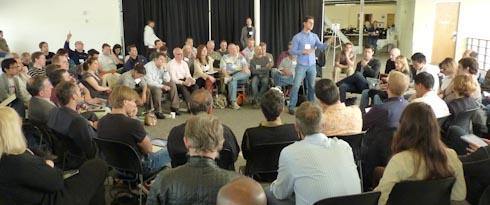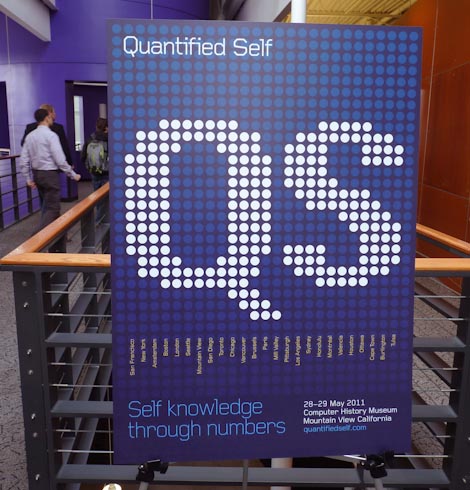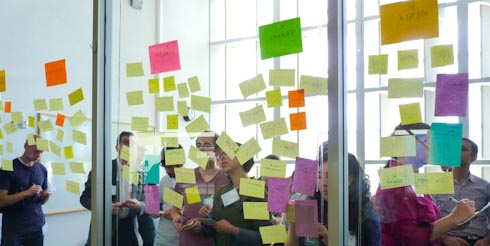The Quantifiable Self

About 400 people interested in serious self-tracking meet for the inaugural Quantified Self conference in May this year. Self-tracking means monitoring quantities like your weight, sleep, location, messages, genes, body chemistry, performance, productivity, or any other of a thousand metrics. Self-trackers arrived from all over the world to share and explore the whys and hows of self-tracking. Self knowledge through numbers we call it. This emerging habit is being propelled by advances in cheap sensors, cheap communication, easier data tools, and our own interest in optimizing our bodies and minds. There are now Quantified Self meetups in 10 countries, and over 200 startup companies in the field. Equally significant, a number of high profile venture capitalists attended the conference, indicating the movement might have reach some kind of threshold.

As one of the founders of this tiny (but expanding) subculture, I gave the closing plenary talk. Lucky for me the best liveblogger in the world was attending: Ethan Zuckerman. Ethan literally wrote the book on how to liveblog a conference, and he “blogged” my talk in real time. Almost as fast as I was speaking, he was listening, digesting, rephrasing, and typing what I said into the internet tubes. Not verbatim, but through the filter of Ethan’s own considerable intelligence. (Ethan himself gave one of my favorite talks at the conference on “informational nutrition.”) The result is a real-time synopsis that is good enough as a post-talk summary. I asked Ethan if I could post his interpretation of my talk here, without corrections (none really needed). I am amazed at how much of my talk Ethan captured, and how accurately. Like simultaneous translation, one must have a gift to do this well.

A lot of what I said is old news to followers of the Quanitifed Self. But there is one new thought I want to emphasized from the talk: Through technology we are engineering our lives and bodies to be more quantifiable. We are embedding sensors in our bodies and in our environment in order to be able to quantify all kinds of functions. Just as science has been a matter of quantification — something doesn’t count unless we can measure it — now our personal lives are becoming a matter of quantification. So the next century will be one ongoing march toward making nearly every aspect of our personal lives — from exterior to interior — more quantifiable. There is both a whole new industry in that shift as well as a whole new science, as well as a whole new lifestyle. There will be new money, new tools, and new philosophy stemming from measuring your whole life. Lifelogging some call it. It will be the new normal.
Ethan’s notes on the rest of my talk:
Quantified self is part of a larger trend in where we’re going. It’s part of listening to the technology and to what it wants to do, because technology is telling us where it’s going. The amount of information on this planet is increasing more quickly than anything we make or than any biological component. It grows at about 66% a year… the rate of Moore’s law.
The most rapid physical production expansions, of things like concrete or oil, is about 7%. (Obviously, there are exceptions like iPads…) Metadata – information about information – is growing even more quickly. 276 exabytes is simply a meaningless number – we know it’s really, really big, but it’s hard to even comprehend.
We’re in the middle of a third paradigm of metaphors and organizing principles for personal computers. We’ve moved from desktop and office metaphors, to page/link and web metaphors, to a new metaphor around streams, tags and the cloud. RSS feeds, Facebook walls, Netflix streams are our general drift at present. This accompanies a shift from the me to the we, and from pages and files to data.
What emerges in this new model are Lifestreams. That’s what we curate in the age of the quantified self. We head upstream, and we leave a wake of data behind us. Lifeloggers, who log everything they do, are pioneers in this space. Gordon Bell and others take these exercises to an extreme, and they’re sharing it, as part of the shift from me to we.
These lifestreams intersect with each other and are, in a way, creating a new media. If we organize computation around lifestreams, an intersection between our lifestreams is a communication, an event of some sort. The media we are in is these streams of data. Everything around us has a sliver of intelligence in it, and is generating bits of data. Each of those objects has a lifestream of data, from the hotel room to your shoes. This environment, with data streams and life streams, is the space where we’ll do the work of the quantified self.
What we’ll see very soon is spectacles and glasses that will let us see that data world. It might be a screen we hold up, but we’ll be able to see this overlay of the digital world embedded in the material world. There’s thinking that the digital life is disembodied bits… but it’s really about bits embedded in the physical world.
A car is a chip with wheels, a shoe is a chip with heels. This isn’t just an internet of things – it’s a database of things. All these words – semantic web, web 3.0 – are describing this data-rich environment filled with these things we make and their data streams.
A movie is made from millions of little pieces. Historically, we made them from bits of film. But now, we might make them from data. There are 151,000 shots of the Golden Gate Bridge on Flickr – there’s no reason to take one. We will reach a moment where it’s no longer useful to film a flyover shot of the bridge. Eventually, we can curate and reassemble a unique film from that database.
This is what we do when we write. We reassemble words from a database of 30,000 or so words, a dictionary. We rarely, if ever, make up words. Much as an Amazon.com page is assembled for us on the fly, we can have database-based cinema, images and writing.
Data is the new media, itself. It’s what we’re going to be swimming in. It’s what the economy is built on.
While I’m sure about that, I have some questions, Kelly tells us. We don’t really care about data, he reminds us – we care about experience. We want experiences from the data, and we may not want to make those experiences ourselves. There’s a tension between wanting that data acquisition to be active or passive. Is the act of checking in on Foursquare, or reporting your weight, a critical part of the process? Successful experiences will shift the attention, at different levels and different amounts. Teachers are good at doing this, helping us shift between the detailed view and the broad view.
Another question is around the question of sharing. We’re still at the beginning of sharing. Everything that can be shared will be shared, because sharing things increases their value. Any data that can be shared will be shared – we know that under the right conditions, with the right permissions and right benefits, people will be willing to share information. But there is a thin line between the quantified self and “intimate surveillance”, a term Marc Smith has coined. There may be a slider between a degree of surveillance and personalization. I want my friends to treat me as an individual with particular needs, and that can only happen if I reveal my likes and dislikes, allowing that surveillance to happen.
The cost of privacy is generic relationships – if you’re unknown to everyone, it’s hard to customize to you. On the other side, you can have high transparency and high personalization, and people seem to be willing to push the slider far in that direction. The difference between quantified self and intimate surveillance is, basically, permission.
A second metaphor is thinking about living in a small town. The woman across the street might know everything about where we’re going and what we’re doing… but we know lots about her, too. Strangers appearing at the house might trigger a call to the cops. That’s a symmetrical and beneficial relationship. It’s uncomfortable once we hit an asymmetry in the data. We may not want less data – we may want more symmetry, more benefits from what the other party knows.
The third question KK offers is who owns this data? Who owns your friendships? There’s another party involved. Who owns your genes? 99.9% are shared by other humans. Who owns your location? The knowledge that you’re in a public space is hard to own. Your reputation or history? Your conversations? The real issue is that we’re moving away from ownership altogether to access. The benefits of accessing are eclipsing the benefits of accessing it – consumers may eventually not own anything at all. Netflix means you can stop owning movies – if you have access to all movies anytime, why would you buy movies? This may be leaking from the virtual to the material world, particularly once we have personal fabrication. It may eventually play out into data, because access is often better than ownership.
The fourth uncertainty has to do with the nature of the quantified self: self knowledge through numbers. The self part is the interesting bit. Technology leads to the extended self. Animals extend themselves through their tools. McLuhan talked about the wheel as the extension of the foot. Computers are extensions of our brains. How far can this go? The quantified self is really the quantifiable self. We are making ourselves quantifiable, wearing, implanting and swallowing gadgets to extend our quantifiability. It’s not just what’s close to us – it’s the environment we move in.
In self-tracking, people change behaviors to become more quantifiable… which in turn helps us make changes. How far will it go?
We should be able to examine our body for toxins, say after we eat something or visit an area with toxic waste. You should be sequencing your genes every hour, 24/7, in real time. We’re going to become quantifiable to the point where we’re real time and changing ourselves in real time.
Those four things, Kelly tells us, he’s not sure about. But he is sure that where technology is going is changing how we know things. Technology modifies how we know – telescopes, microscopes have made a new method of knowing possible: science. If science is how we know, technology modifies how we know. There is no written history of the scientific method. KK has been cobbling together a history of high points: the controlled experiment in 1580 (Bacon); the necessity of repeatability, invented in 1665 (Boyle); falsifiable testability (Popper, 1920): randomized sample (Fisher, 1926); controlled placebo (1937), computer simulations (1946), double-blind experiment (1950). The scientific method is going to change more in the next 50 years than it has in the past 400 years.
THrowing away negative results is a crazy idea – we’ll be saving those. Triple blind trials ensure that not only do the experimenter and subjects not know the answer, you aren’t even aware an experiment is going on. Quantified Self is right in the center of what’s going on: clinical trials of 1, real-time experiments instead of batch mode, personalized pharma, participatory medicine, wikified results that are never final. Exhaustive data, the Google way of doing science, is better than having a hypothesis. Collaborative research, where many people do research in tandem on a vast scale.
Your trivial-seeming self tracking app is part of something much bigger. It’s part of a new stage in the scientific method, another tool in the kit. It’s not the only thing going on, but it’s part of that evolutionary process. Making drugs for one person won’t come purely from the quantified self, but it’s part of that process.
You might object to a decentralized, peer to peer, amateur, never finished unauthorized encyclopedia… but you’d be wrong. What happens when this happens to medicine?


